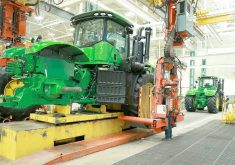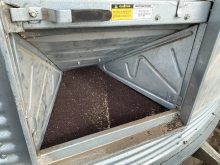If feedlot owners or final sellers want to reap the value of age verification from a market premium, they should be obliged to buy that information from the original owner at a negotiated price.
You have to hand it to Alberta Agriculture officials, when they make a policy decision they intend to fight for it to the taxpayers’ last dollar. It all has to do with the fate of the provincial age-verification program (AVP), which more and more cattle producers are resisting to embrace. And no wonder. Unless you sell finished cattle directly to processors, you are unlikely to reap any actual cash premium for your paperwork efforts. Many primary producers see the program as another gift to feedlot operators who have no intention of sharing any AVP premiums. The result has been a growing resistance by producers to age verify calves even though it is required by provincial law.
Read Also

Farm equipment sales sector sees significant structural changes
Farming equipment sales have been declining for a number of years now, and one industry professional believes structural changes in the industry are needed to curb that trend.
Cow-calf producers sensed correctly that the government was in no position to enforce their own law, so flaunting it was an easy way to protest the perceived unfairness of the regulation.
Faced with a rebellion against AVP, the government resorted to that favourite time-tested scheme – buying compliance with your own money. The minister recently announced an AVP incentive program that would see $15 million provided to cattle producers who age verified their cattle for the next three years. Its not the first time the government has used this tactic. A couple of years ago they used the Industry Recovery program payouts to force age-verification compliance. As that past program proved, producers will comply with any program if there is a cash incentive involved. Of course primary producers would also happily comply if the market instead of the taxpayer provided the age-verification premium
Therein lies the problem with the AVP program. The government is forced to prop it up because the market is not providing the incentive to the primary producer. Until that changes in a way that is clear to the producer, the minister may well have to provide an annual incentive for years to come and all for what? The landscape is littered with the bones of taxpayer dollars used in futile attempts to change the market according to government perceptions.
This may be cynical, but one almost expects the retail price of eartags to increase exactly to match the amount of any per-tag incentive. Those that have long memories would remember that’s how past hay support programs worked. History does have a habit of repeating itself. That’s something a new generation of Alberta Agriculture officials will have to learn.
A better way
There has to be a better way to make age verification work for primary producers. There are new information systems either existing or being developed that should be able to identify individual cattle ownership right back to the primary producer. If age verification has a market value, it should be owned by the person who originally made the effort to create the value when the calf was born. If feedlot owners or final sellers want to reap the value of age verification from a market premium, they should be obliged to buy that information from the original owner at a negotiated price. Both parties should be able to benefit. Right now, as primary producers are clearly aware, when they age verify, they give that information away for free and never see a dime for their efforts.
Having said all that, there is another reality that is the elephant in the room. Most of the finished-cattle market could care less about age verification, being the overwhelming main export market remains the U.S., where Canadian-style age verification means nothing. Age verification only affects a select export market, primarily in Asia which restricts access by age. Even that may change in the future as trade restrictions are eased.
Be that as it may, what we have in Alberta is the ongoing situation where we in effect may have millions of age-verified cattle for which there is only a very small market that would pay a premium. That’s what primary producers see and they would be right in assuming that those that want to access those premium markets need to pay them a piece of the action if they want age verification information.
Industry and government officials will drag out that old saw about how age verification is needed to maintain and expand export markets. One can accept that to a point, but two nagging matters come to light; competing U.S. beef exports are subject to dentition age verification, a much cheaper and easier process. The other matter is whether Canadian taxpayers should be subsidizing food going to premium export markets. I believe the latter will become a growing concern with the public as to its logic at their expense.














